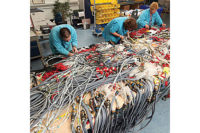Over the last 26 years, since the founding of CAMI Research Inc., customers and friends have asked why the company would focus its efforts on such a mundane, low-tech, and uninteresting device as a cable tester, particularly since a variety of such devices already existed. On the surface, testing wiring assemblies might seem to be mundane. Instead, the incredible variety and richness of applications I describe below demonstrate that it is not.
While a simple LED circuit can show continuity in a wire, the technology needed to meet increasingly complex and demanding customer quality standards is as different from an LED circuit as lightning is from a lightning bug. I first learned this lesson in 1991, when we began work on the CableEye tester.
At that time, the USB interface did not exist. Instead, computer peripherals—including printers, scanners, modems and industrial controls—used serial ports to communicate with computers, a technology developed in the early 1960s when teletype machines were in wide use. Initially, serial port cables used DB25 connectors and followed the RS232 standard developed by the Electronic Industries Association.
For reasons of cost, competitive advantage and advancing technology, very few manufacturers followed this standard exactly, and different, usually incompatible, serial cable wiring proliferated. Using a wrongly wired cable having DB25 connectors that obligingly fit most serial devices could cause device malfunction, or worse, circuit damage.
With mass production came molded connectors, now making it impossible to remove a cable’s backshell to see which color wire was connected to which pin. This left us with the mind-wrenching task of using an ohmmeter or beeper to buzz out a cable to ascertain suspect wiring.
To address these problems, our company decided to develop a computer-based product to which a serial cable could be connected and its wiring instantly displayed on the computer screen. We succeeded after two years of hard work, but it quickly became apparent that customers needed to test cables with many other connector styles, and they required measurement capability beyond simple continuity to certify connection quality and search for various assembly defects like intermittent connections.
Since the first CableEye tester was introduced in 1993, we have continually adapted to meet these ever-changing needs. The case studies that follow show some of the unusual applications we have encountered over the years.
Please note that in this article, “cable” refers to any wiring assembly that might be found in an automobile or aircraft: from a simple lamp cord to a complex wire harness.
Keeping Wiring Dry Underwater
Autonomous underwater vehicles are small, unmanned submarines that can operate without remote human intervention. Many companies, including the Woods-Hole Oceanographic Institute, Bluefin Robotics and Boeing, make such devices of wide-ranging size for various purposes. Our customer, Hydroid in Pocasset, MA, makes deep-diving vehicles for ocean exploration at depths of up to 6,000 meters.
During the manufacture of these vehicles, various hull penetrations are necessary to admit wiring for external cameras, sonar, and electronic sensors. With great pressure present at normal operating depth, water may seep through microscopic defects in wire insulation that would eventually lead the electronics to malfunction. As a result, all vehicles are tested in the factory using a large tank that can be pressurized to simulate the deep ocean. While under pressure, high-voltage cable testing can reveal insulation defects that cause conductive liquid, like seawater, to penetrate copper conductors.
To test the quality of electrical insulation, we normally apply voltage between two unconnected wires and look for leakage between wires in fractions of a microamp. To obtain better than 1 gigohm of isolation between two wires, we would apply 1,000 VDC between the wires and expect to see leakage of less than 1 microamp.
The challenge in this application is that the water itself must serve as one of the conductors so that we can detect leakage under the insulation to a single wire rather than between two wires. However, the cable tester’s electronics require that all points be electrically isolated from earth ground so that each wire can be individually energized while the other wires are not.
A body of water, unfortunately, is, of course, always at ground potential, including a water tank attached to a grounded structure. As a result, using the water itself as a test point becomes problematic. Since we could not electrically isolate the water in the tank, we instead isolated the tester and computer from ground by powering both through an isolation transformer. This permits successful measurements between the water and the wiring to confirm that the insulation remains intact.
Catheter Testing
Medical catheters for electrical sensing or stimulation comprise small tubes containing extremely thin wires (fractions of a millimeter) that lead from an electrical connector at the near end to evenly separated electrodes along a short length of tube at the far end. Testing such an assembly can sometimes prove quite challenging.
For example, simply clipping a minihook connector to each electrode would not only be awkward, but could apply enough force to the electrode to deform it. The special fixture we developed, however, allows the operator to make physical contact with the electrodes without damaging them.
We milled a circular groove in a 0.093-inch-thick fiberglass circuit board to about half its depth. On the other side of the board, we milled slots perpendicular to the circular groove spaced at the positions of the catheter’s electrodes to just over half the depth of the board. This exposed openings along the circular groove where the electrodes would be located.
By soldering-in a specially designed spring pin on the back side of the board to terminate at each opening along the groove, we made electrical contact with the catheter. A circular clamp closing from above applied uniform pressure around the catheter to ensure that all electrodes touched the spring pins. Once mounted, a test with resistance can be completed in about one second.
Slip Rings and Signal Transmission
Slip rings provide continuous electrical contact with rotating objects such as a constantly turning radar antenna. Newly manufactured slip rings require testing to ensure that low electrical resistance exists uniformly for the full 360-degree circle of rotation. Any discontinuities in electrical resistance could cause serious equipment malfunction, or arcing if the rings transmit power. Also, because some element of friction exists at the contact point between rotor and stator, periodic testing becomes necessary for equipment taken out of service for maintenance.
For this application, we modified the tester’s firmware to make repetitive four-wire Kelvin resistance measurements at the rate of 500 per second. Because the sampling process is not synchronized with the rotation, several rotation cycles are needed to ensure that we collect enough resistance samples around the circumference. The cycles also provide a high degree of confidence that the rings transmit electrical signals reliably through their full span of rotation.
Dummy Data Preserved
Crash test dummies substitute for human subjects when automotive manufacturers intentionally stage collisions to test vehicle safety systems. Unlike humans, these anthropomorphic creations contain numerous embedded sensors, including accelerometers, load sensors, strain gauges, temperature sensors, angular rate sensors, air pressure sensors and position sensors located where body stress and injury are most likely.
Not surprisingly, these many sensors link to data acquisition modules using cables exposed to the same forces experienced by the various sensors. Following a crash experiment, these cables must be carefully inspected and electrically tested before reuse, especially considering the expense of a destroyed test vehicle and the possible loss of data from a failed cable.
Long Cables With High Voltage
Extremely long cables connect computers, sensors and other equipment separated by distances of thousands of feet or more, sometimes by miles. Simply connecting long cables to a modern cable test instrument without making some adjustments to the measurement process will produce spurious data. As wires increase in length, each wire begins to look more like the plates of an elongated capacitor, particularly when a shield conductor exists.
Automatic cable testers, unlike ohmmeters, use a series of rapid pulses to acquire connection and resistance data. Unfortunately, the parasitic capacitance of a long cable distorts these pulses. For connectivity and resistance measurements, generally widening the test pulses
addresses the problem by permitting the tester’s drive circuit more time to pump charge into the parasitic capacitance before reading back a response.
The downside of this approach is it lengthens test time. As with the autonomous submarine testing cited earlier, the cable must be isolated from earth ground, or if this is not possible, the tester and computer must be.
High-voltage testing of long cables presents us with the same capacitance issue, but in this specific application, the inrush current needed to bring the cable up to the test voltage may exceed the current level that would normally signify insulation breakdown (i.e., the “trip current”). In this case, we reduce the ramp rate to gradually increase the test voltage.
Testing long cables with high voltage also introduces a serious safety concern. Unlike the low voltage test for continuity and resistance that uses 10 VDC pulses, a hipot test may apply 500 VDC or more to the cable to test insulation properties and leakage.
We can certainly reduce the ramp rate while raising the voltage from 0 volts to the test voltage. However, as we do so, we pump considerable charge in the cable due to its large capacitance. If, for any reason, a person should come into contact with the far end of a long cable during the hipot test, they could receive a lethal electrical shock from the cable’s stored charge discharging through their body. Therefore, this demands special care on the part of those operators performing the test.
Connector Panels for Concerts
Many people enjoy the live concert venue featuring rock musicians, vocalists and flashy laser light and sound effects. Few people know about the enormous effort required to set up one of these concerts, or the large and varied number of cables necessary to make everything work. These include cables for power, lighting, microphones, speakers, video projectors and cameras, laser and special effect controls, and mixer panels.
Several of our customers specialize in the rental of cables and equipment needed to support these concerts. With cables connected and disconnected for each show, walked over, rolled over by forklifts, and generally manhandled during this process, testing the interconnect cables before each show becomes critically important.
To this end, special large connector panels have been designed for this purpose. One such panel is portable and includes an internal CableEye test system, computer, printer and mating connectors for all cables a show technician might use.
Keeping Moisture at Bay
Woods Hole Oceanographic Institute, and the National Oceaniac and Atmospheric Association, among others, conduct research in the deep ocean to monitor wind speed and direction, air temperature, sunlight, surface and subsurface water temperature, and water current. Moored buoys powered by solar panels collect this data, transmit it to satellites, and remain in a fixed location by cables attached to an instrument package on the ocean floor.
Cables that connect the buoy to the instrument package not only hold the buoy in position, but also transmit power to, and exchange signals with, these instruments. The cables typically use heavy rubber insulation several inches thick to keep high-pressure seawater from penetrating to the internal copper conductors.
A tour of duty for a buoy and its cables typically lasts one year. Because it’s very expensive to replace these cables, they are made in 50-foot sections and interconnected to obtain the desired overall length, with each section individually testable and reusable. End-users regularly rely on a hipot test to reveal if any moisture penetration has reached the copper conductors. If not, the test certifies that the cable section is ready for the next deployment.






